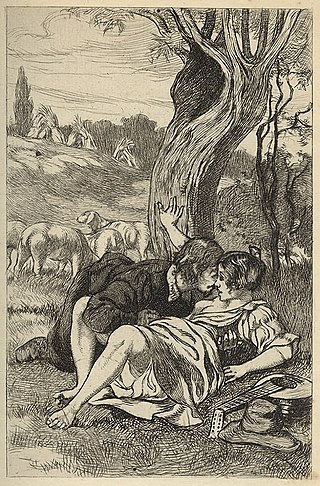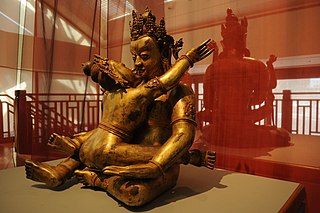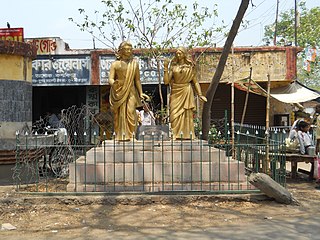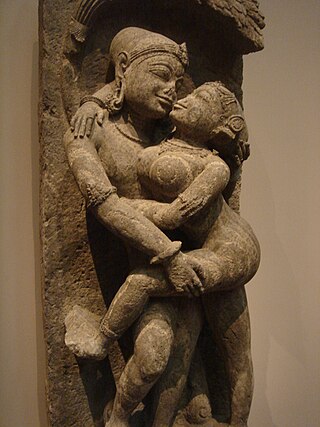
Chakras are various focal points used in a variety of ancient meditation practices, collectively denominated as Tantra, or the esoteric or inner traditions of Hinduism and Buddhism.

Tantra is an esoteric yogic tradition that developed on the Indian subcontinent from the middle of the 1st millennium CE onwards in both Hinduism and Buddhism.

Vajrayāna, also known as Mantrayāna, Mantranāya, Guhyamantrayāna, Tantrayāna, Tantric Buddhism, and Esoteric Buddhism, is a Buddhist tradition of tantric practice that developed in the Indian subcontinent and spread to Tibet, Nepal, other Himalayan states, East Asia, and Mongolia.

Yoni, sometimes called pindika, is an abstract or aniconic representation of the Hindu goddess Shakti. It is usually shown with linga – its masculine counterpart. Together, they symbolize the merging of microcosmos and macrocosmos, the divine eternal process of creation and regeneration, and the union of the feminine and the masculine that recreates all of existence. The yoni is conceptualized as nature's gateway of all births, particularly in the esoteric Kaula and Tantra practices, as well as the Shaktism and Shaivism traditions of Hinduism.

A yogi is a practitioner of Yoga, including a sannyasin or practitioner of meditation in Indian religions. The feminine form, sometimes used in English, is yogini.

Foreplay is a set of emotionally and physically intimate acts between one or more people meant to create sexual arousal and desire for sexual activity. Although foreplay is typically understood as physical sexual activity, nonphysical activities, such as mental or verbal acts, may in some contexts be foreplay. This is typically the reason why foreplay tends to be an ambiguous term and means different things to different people. It can consist of various sexual practices such as kissing, sexual touching, removing clothes, oral sex, manual sex, sexual games, and role playing.

Tantric sex or sexual yoga refers to a range of practices in Hindu and Buddhist tantra that utilize sexuality in a ritual or yogic context. Tantric sex is associated with antinomian elements such as the consumption of alcohol, and the offerings of substances like meat to deities. Moreover, sexual fluids may be viewed as power substances and used for ritual purposes, either externally or internally.
Coitus reservatus, also known as sexual continence, is a form of sexual intercourse in which a male does not attempt to ejaculate within his partner, avoiding the seminal emission. It is distinct from death-grip syndrome, wherein a male has no volition in his emissionless state.
Sex magic is any type of sexual activity used in magical, ritualistic or otherwise religious and spiritual pursuits. One practice of sex magic is using sexual arousal or orgasm with visualization of a desired result. A premise posited by sex magicians is the concept that sexual energy is a potent force that can be harnessed to transcend one's normally perceived reality.
Neotantra, navatantra, or tantric sexuality is a Western new religious movement influenced by the Eastern esoteric spiritual traditions of Tantra. Rooted in elements of Hindu and Buddhist tantras, neotantra blends New Age interpretations with modern Western perspectives, often emphasizing the sexual aspects of these ancient traditions. While some proponents reference traditional texts and principles, many utilize tantra as a broader term encompassing sacred sexuality, occasionally incorporating unconventional practices. However, neotantra does not always adhere to the complete range of Indian tantric practices, particularly the reliance on a guru.

Pompoir is a sexual technique in which the woman uses her vaginal muscles to stimulate the man's penis. Both partners remain still, while the woman strokes the man's erection using rhythmic, rippling pulses of the pubococcygeus muscles, so this practice is best performed in a woman on top position.

Vaiṣṇava Sahajiyā was a form of Hindu tantric Vaishnavism focused on Radha Krishna worship that developed in Eastern India. This tradition flourished from the 16th to the 19th century. The Vaiṣṇava Sahajiyā tradition produced many great poets who wrote in the Bengali language, the most famous of these poets all wrote under the pen name Chandidas. Their religious literature was mainly written in Bengali vernacular.
Fur massage is a form of touch that is used in partner massage. It involves using a fur glove to touch one's partner in an attempt to arouse. In therapeutic usage, professional boundaries do not permit that the therapist (giver) be emotionally involved in a massage. Fur massage mitts are sometimes recommended by professionals as a sensual toy rather than sexual toy. Use of fur gloves for massage is considered a safe sex practice by the Institute for Advanced Study of Human Sexuality.

Maithuna is a Sanskrit term for sexual intercourse within Tantra, or alternatively for the sexual fluids generated or the couple participating in the ritual. It is the most important of the Panchamakara and constitutes the main part of the grand ritual of Tantra also known as Tattva Chakra. Maithuna means the union of opposing forces, underlining the nonduality between human and divine, as well as worldly enjoyment (kama) and spiritual liberation (moksha). Maithuna is a popular icon in ancient Hindu art, portrayed as a couple engaged in physical loving.
Barbara Carrellas is an author, sex educator, performance artist, and certified sexologist accredited through the American College of Sexologists. She facilitates workshops in which participants explore sexuality through a holistic approach that includes practices like erotic breathwork and Tantra, and she has lectured at various institutions, including the Museum of Sex in New York City, Vassar College, Barnard College, and the Chicago Art Institute. She is known for her "breath and energy orgasm" techniques, which she says are "orgasms you can have using your imagination and your breath." Carrellas learned the technique during the height of the AIDS epidemic as a way for people to orgasm without physical contact. Such techniques, she says, offers a way for "people to have more safer-sex options."

Kali's Child: The Mystical and the Erotic in the Life and Teachings of Ramakrishna is a book on the Indian mystic Ramakrishna by Hindu studies scholar Jeffrey J. Kripal, published in 1995 by the University of Chicago press. It argues for a homoerotic strain in Ramakrishna's life, rituals, and teachings.

Yoni massage or yonic massage, derived from the word Yoni, a representation of the vulva which symbolizes the goddess Shakti, is a type of Tantric full-body massage. It primarily focuses on the labia, clitoris, G-spot, uterus, the breasts, the anus and other erogenous zones. Yoni massage is the female equivalent of a Lingam massage. The massage is viewed as therapeutic and is sometimes used as a method of relieving tension, pain, or general discomfort of the vagina. It has been claimed by some practitioners to be helpful to achieve fertilisation, although there is no scientific support for this claim.
Mark A. Michaels and Patricia Johnson are authors and lecturers on sexuality and relationships. Their approach is informed by their combined 30 years of Tantric study, practice and teaching.

A lingam, sometimes referred to as linga or Shiva linga, is an abstract or aniconic representation of the Hindu god Shiva in Shaivism. It is typically the primary murti or devotional image in Hindu temples dedicated to Shiva, also found in smaller shrines, or as self-manifested natural objects. It is often represented within a disc-shaped platform, the yoni – its feminine counterpart, consisting of a flat element, horizontal compared to the vertical lingam, and designed to allow liquid offerings to drain away for collection. Together, they symbolize the merging of microcosmos and macrocosmos, the divine eternal process of creation and regeneration, and the union of the feminine and the masculine that recreates all of existence.

Joseph Kramer or Joe Kramer is an American sexologist, filmmaker and somatic sex educator. He is the founder of the Body Electric School and of the profession of Sexological Bodywork.













